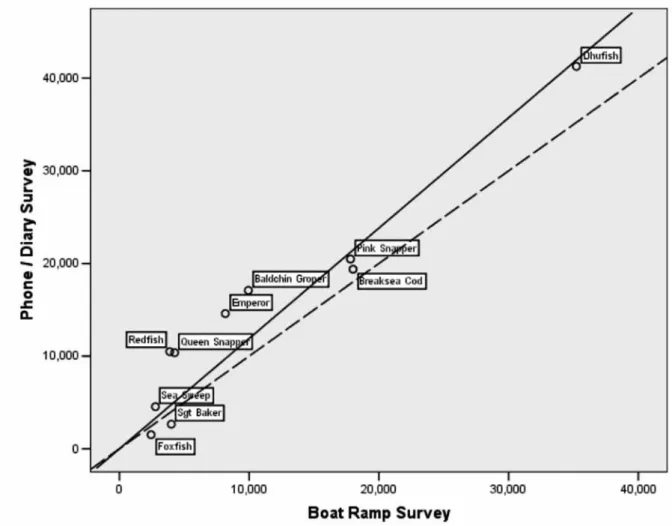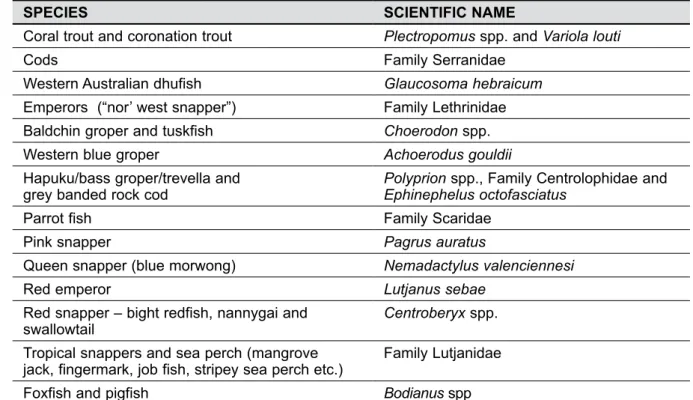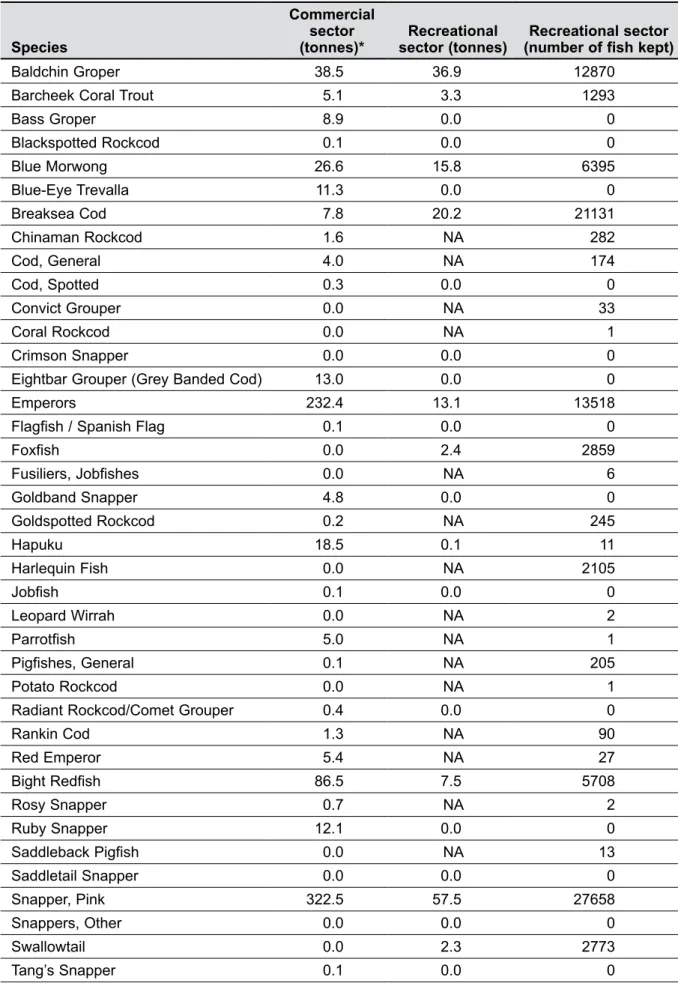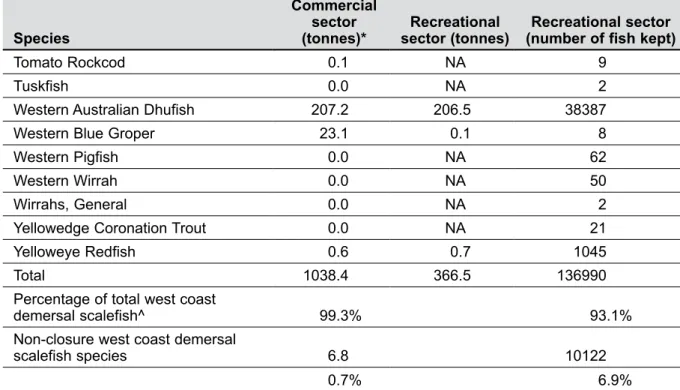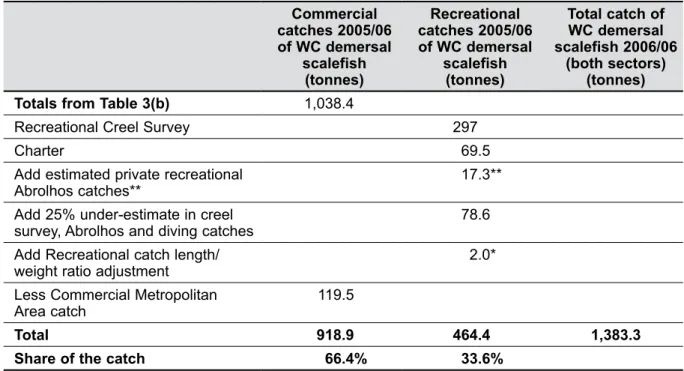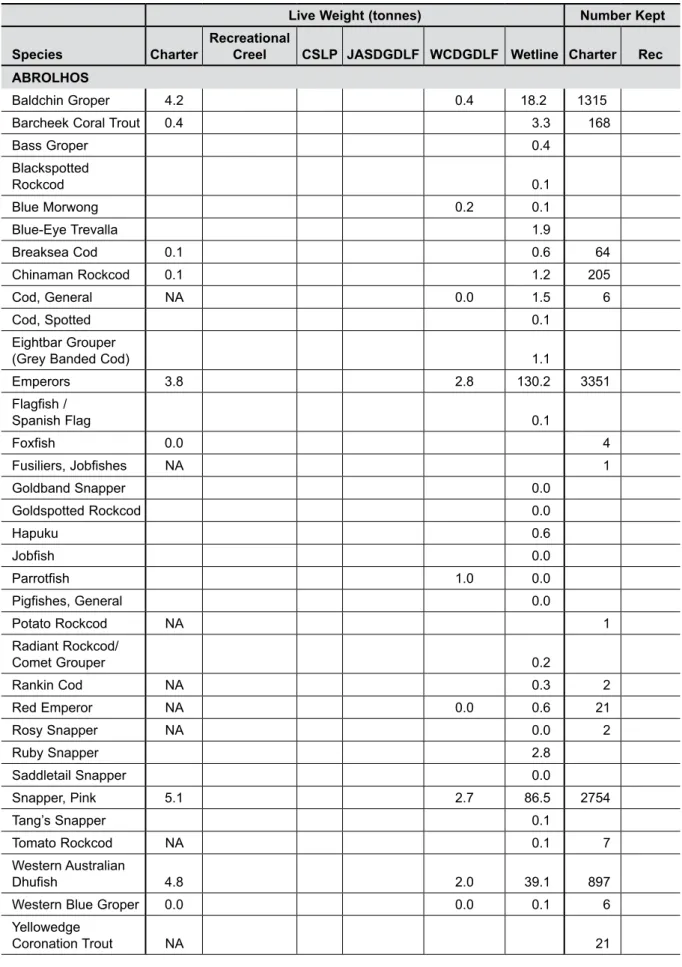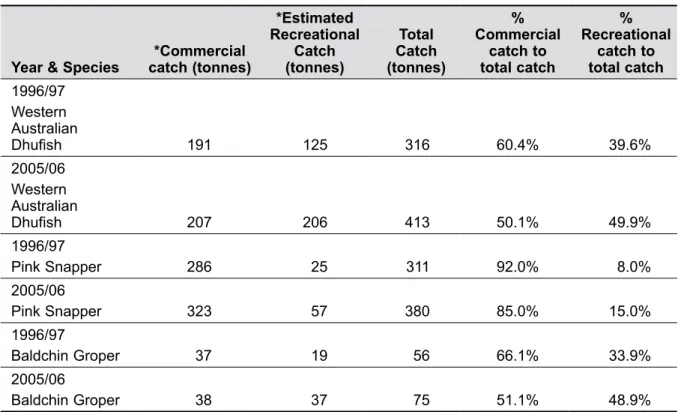The Integrated Fisheries Allocation Advisory Committee (IFAAC) will consider the content of all submissions when preparing the final report to the Minister of Fisheries and may make changes to its initial position as necessary and if required. A summary of all submissions will be provided to the Minister at the time the IFAAC submits its final report to him.
CoMMIttee’s draFt reCoMMendatIons
A redistribution mechanism should be introduced as soon as possible for demersal scale fish stocks on the west coast. A system for monitoring sectoral catches, based on the principles set out in the document.
Items to Note
Department of Fisheries telephone log surveys indicated that the catch of key indicator species in the West Coast demersal squab fishery is about 20 percent higher than the catch reported in Fisheries Research Report no.
IntroduCtIon
The IFAAC
Disclosure of interest
If a member had an interest in any matter to be considered by the IFAAC, the member disclosed the interest, the disclosure was recorded in the minutes of the committee, and the member did not vote on the matter.
Guiding principles
The IFAAC’s terms of reference
The second stage of the West Coast demersal crustacean resource process was completed in December 2009 when the Department of Fisheries submitted an IFM resource report to IFAAC. This report was the main source of information used by IFAAC in considering allocations for the demersal crustacean resource on the West Coast.
Ministerial Advice
Allocation to the non-fishing sector
In the case of the demersal crustacean source on the west coast, the first stage (point one above) of the process was unnecessary, as the former Minister of Fisheries, Mr. Jon Ford, MLC, has already called for IFAAC to provide advice and recommendations on allocations.
Additional Guiding Principles Adopted by the IFAAC
Optimising benefit to the community
The results of the study indicated little redistribution of catch from the recreational sector to maximize the net economic benefits of the use of the resource. However, the authors cautioned against using the results at this time because some of the underlying assumptions that were present at the time of their report are not currently met.
Ministerial action
Allocation decisions should seek the optimal benefit to the Western Australian community for the use of fishery resources and should take into account economic, social, cultural and environmental factors. Realistically, it will take time to achieve this and the implementation of these objectives is likely to be incremental over time.
Description of the Fishery
Recreational
In September 2009, the Minister, the Honorable Norman Moore MLC, announced amended management arrangements for recreational fishing in the recreational WCDSF fishery, still aiming to reduce recreational catches by 50 per cent. To allow any angler who does not have a boat recreational fishing license to fish from a boat in the company of a licensed boat angler within the licensed angler's bag limit.
Commercial
CatCh InForMatIon
Catch Data Uncertainty
Despite the significant increase in information generated over the past five years, the limited availability of useful historical data meant that it was not possible to develop stock assessment models that could reliably estimate biomass. With the limited availability of useful historical data, where it was not possible to develop stock assessment models that reliably estimate biomass, the current assessment for the West Coast Demersal Fish Fishery is based on a 'weight of evidence' approach.
Customary
17710, states that total catch levels (recreational catch) were underestimated and that the measures of precision associated with the estimates were greatly underestimated.
Recreational
The current assessment of the West Coast Demersal Fish Fishery, where it has been possible to develop stock assessment models that reliably estimate biomass, is based on a 'weight of evidence' approach including fishing mortality derived from length/ age. IFAAC considers that because there is insufficient information, there is strong justification for using the 2005/06 data as a benchmark, which is the most recent data set.
Commercial
Recreational and Commercial Catch Shares
Comparative Data Sources
The Multi-Zonal Aspects of the Fishery
In discussion with the Department of Fisheries and key stakeholder groups, IFAAC considered whether any of the areas considered for commercial fishing should also be considered for recreational fishing, so that there would be different allocations for different areas. Management of recreational fisheries is difficult because where the number of recreational fishers is limited and it is not possible to know who they are, catch information for each area is inevitably imprecise. These were the metropolitan area (no commercial fishing allowed), the offshore area (in waters deeper than 250 meters) where recreational catches are very small, and the Kalbarri area where most of the catches are done by the commercial sector.
The catch of the foreign species is included in the catch reports, and it is therefore possible to assign the range of species caught in these areas.
An Appropriate Suite of Species
Commercial and recreational catches of the dominant 15 West Coast demersal scale fish species in 2005/06, based on the commercial and charter sector fishing returns and the 2005/06 recreational fishing survey. Catch of west coast demersal scalefish in the 2005/06 recreational fishing closure list within sectors, based on the commercial and charter sectors' fishing returns and the 2005/06 recreational fishing troll survey. The recreational closure list of species as shown in Table 3(b) accounts for 99.3 percent, by weight, of the commercial catch and 93.1 percent.
The list of species prohibited for recreation, as shown in Table 3(b), represents 99.3 percent of the commercial sector catch and 93.1 percent of the West Coast demersal crustacean catch (as listed in Appendix 7) in the recreational sector.
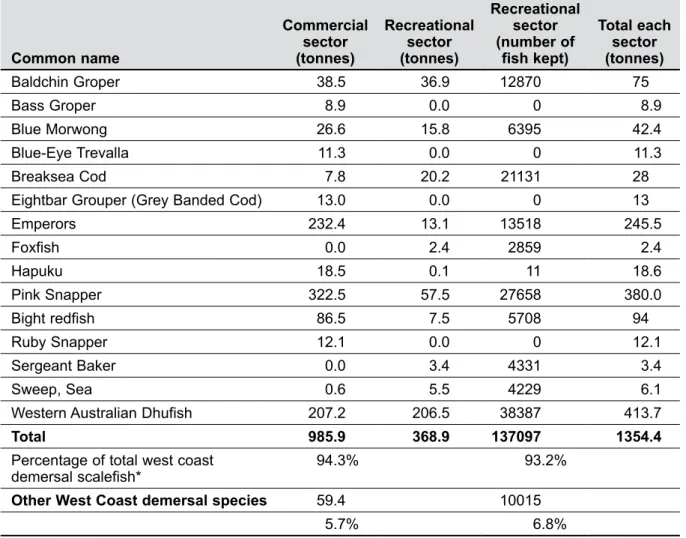
The Multi-User Nature of the Fishery
To provide the baseline for intra-sectoral catch shares Table 5 lists the catches of west coast demersal scalefish by charter boats and private boats within the recreational sector and by the 'wetline' fishery (now the West Coast demersal scalefish interim managed fishery), the two demersal gillnet and demersal longline fisheries within the commercial fishery and the Commonwealth trawl fishery. It noted that the charter industry is currently being reviewed and is of the view that this review should not change the 2005/06 shares for the recreational catch. IFAAC noted that catches for the Commonwealth-managed Western deepwater trawl fishery were inconsistent but generally of a low level.
IFAAC is of the view that as a commercial fishery, the Commonwealth managed Deepwater Trawl Fishery is part of this allocation process and the offshore species they target should be included in the allocations.
Relative Proportions of Sectors
As discussed in section 4.2, IFAAC does not believe it is appropriate to allocate a customary share of the resource, as there is no evidence of customary fishing for halibut on the west coast.
Proportional Allocations for the Recreational and Commercial Sectors
Under-estimation of the recreational catch in the 2005/06 creel survey
List of adjustments to the catch levels in tables
Customary fishing
Reallocation Mechanisms
Monitoring Allocations
Management of Allocations
Consultation Mechanisms
Legislative Arrangements
Final report for Fisheries Research and Development Corporation Project No. 191, Department of Fisheries, Western Australia. 2009) “Management and monitoring of fish spawning assemblages within the West Coast Bioregion of Western Australia. O'Neill, M (2009) 'Scientific Review of the West Coast Demersal Fish Fishery, Western Australia', Fisheries Case Publication No.
Steffe, A (2009) "Review of Fisheries Research Report (177)" Fisheries Occasional Publication No Department of Fisheries, Western Australia.
Integrated Fisheries Management Government Policy
A sustainability report will be prepared for each fishery considered under IFM policy under the 'Policy for the Implementation of Ecologically Sustainable Fisheries and Aquaculture Development in Western Australia'. In the interim, each sector will continue to be responsibly managed within current catch ranges and should a sector's catch change disproportionately compared to other sectors, the Minister will take appropriate management action to address this problem. These will be formalized on the basis of proportional catch shares using the best information available at the time the Integrated Fisheries Allocation Advisory Committee begins its process (see below).
The Minister will be responsible for determining the process and timeframes for resolving allocation issues in each fishery based on advice from the CEO of the Department of Fisheries and the Integrated Fisheries Allocation Advisory Committee.
Integrated Fisheries Allocation Advisory Committee
Once IFAAC has reached an initial position in relation to allocation, this will be documented, together with the reasons for its conclusions, and IFAAC will recommend to the Minister that it be released as a 'draft allocation document' for public comment, which will include submissions invite. . Once the comment period has closed, and IFAAC has considered the submissions received, IFAAC will finalize its position and submit a final award report to the Minister. The Minister for Fisheries will then consider the recommendations of IFAAC and determine the allocations.
The Minister has agreed to give an explanation of his decision to publish his decision in an award case.
Minister’s letter to IFAAC
Boat-based Recreational and Commercial Catches 2005/06
Commercial catch of recreational walleye species by area in 2005/06. tons) Total commercial catch (tons).
Zonal Catches of Species Subject to Recreational Fishing Closure
Key Indicator West Coast Demersal Scalefish Species Taken by
Whole Suite of West Coast Demersal Scalefish
311014 Epinephilidae Blacktip rockcod Epinephelus fasciatus Serranidae/Epinephelidae 311079 Epinephilidae Blouvlekkoraalforel Plectropomus laevis Koraalforel en. 311136 Epinephilidae Bluespotted rockkabeljou Cephalopholis cyanostigma Serranidae/Epinephelidae 311008 Epinephilidae Brownbarred rockcod Cephalopholis boenak Serranidae/Epinephelidae 311078 Epinephilidae Gewone koraalleopard P. 311058 Epinephilidae Rankin kabeljou Epinephelus multinotatus Serranidae/Epinephelidae 311149 Epinephilidae Snubnose grouper Epinephelus macrospilos Serranidae/Epinephelidae 311162 Epinephilidae Vermicular troud Plectropomus oligathus.
Serranidae/Epinephelidae 311035 Serranidae Western wirrah Acanthisius serratus Serranidae/Epinephelidae 311085 Serranidae Whitelined rockcod Anyperodon leucogrammicusSerranidae/Epinephelidae 311199 Serranidae Ac Wirrahistius, sp.
Catches (By Weight And Area) of Key Indicator Species
For example, using only the weights of catches for the three indicator species, or the top 10 species per zone from both commercial and recreational sectors, can be used to monitor allocations. This approach to monitoring allocations still uses the entire demersal list of species to make the initial allocation]. It is a similar philosophical approach to using the three indicator species to monitor the status of the entire range of demersal species on the west coast.
This is critical given the resources available and the likely frequency of monitoring allocations for the West Coast and for other bioregions in the future (eg Gascoyne).
Catches (by Weight and Area) of Key Indicator Species in 2005/06
Memorandum from Director of Research, Regarding Estimation of
One limitation for the telephone diary survey is that the smaller sample sizes compared to the bantam survey may limit the scope of the outputs. These ten species represent more than 95 percent of the demersal catch of boat-based fishermen in this bioregion. Therefore, estimates of the catch of demersal fish by boat-based recreational fishers are underestimated by a material level.
The "point" estimate generated by the regression method of the level of underestimation by the creel survey method was 19 percent.
